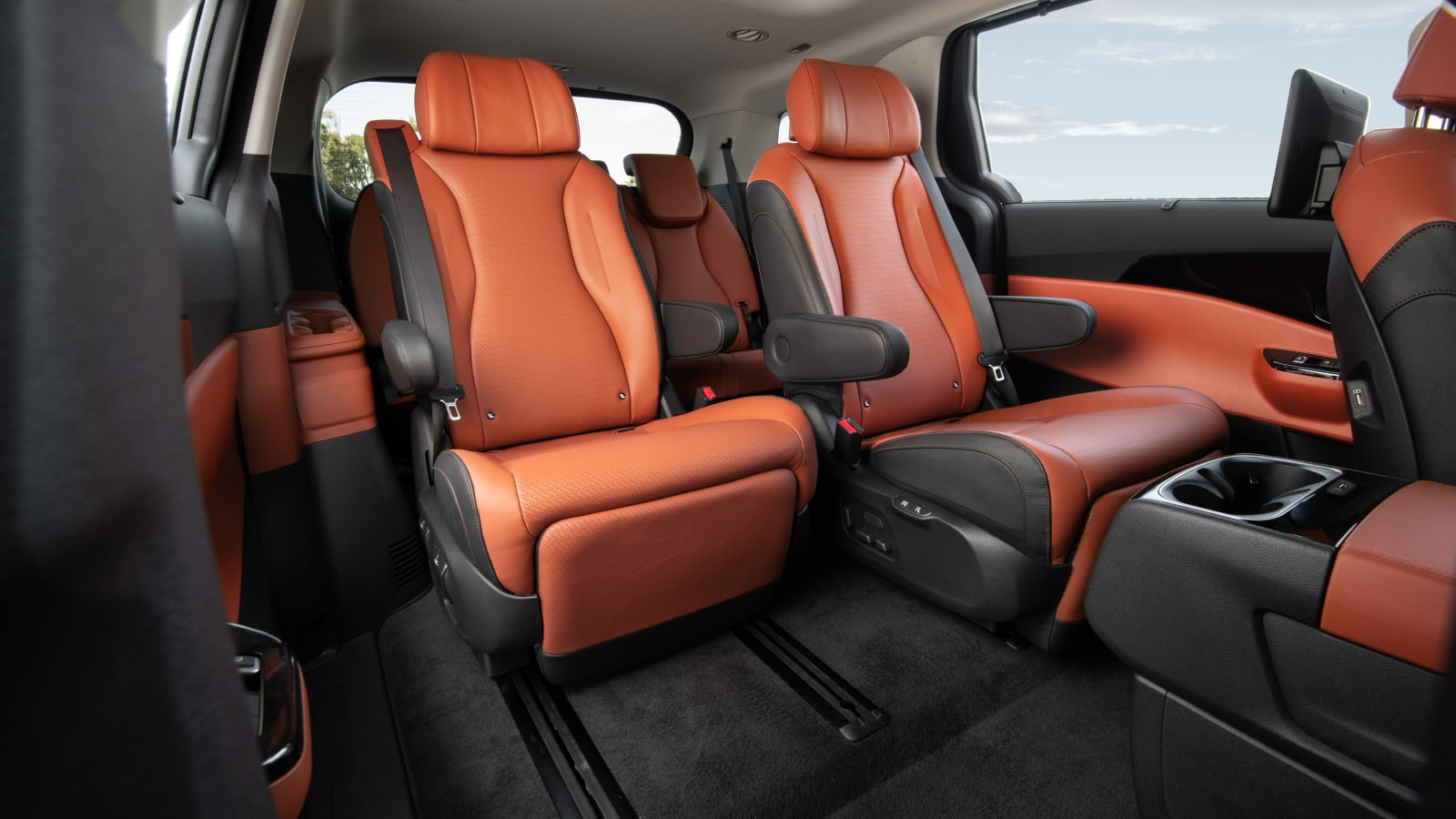The 2022 Kia Carnival has finally made its American debut, officially displacing the Sedona. Even though Kia won’t call it a minivan (you won’t find a single reference to it being a “van” or “minivan” in the press release) the Carnival is totally and unequivocally a minivan. Great! We love vans here at Autoblog.
Kia is entering the Carnival with a fray of other newly redesigned or refreshed minivans this year, meaning that it won’t exactly be a winner by virtue of freshness or modernity alone. Both the Honda Odyssey and Chrysler Pacifica walked into 2021 with significant refreshes, and the Sienna is completely new from the ground up. Thankfully for Kia, the Carnival is totally new, as well. It’s riding on a new platform, sporting a new engine and features a wildly luxurious interior at the top end.
Where we might’ve been able to write the Sedona off as dated previously, that won’t be the case with the Carnival. Let’s start with some numbers. The big spec sheet is below.
Engines and drivetrain
The 2022 Kia Carnival has more power than anything else in its class at 290 horsepower from its 3.5-liter V6. It’s also the lightest of the bunch at just 4,376 pounds, so in theory, the Carnival should be the quickest. The seat-of-the-pants difference between the Carnival, Pacifica and Odyssey is likely to be negligible, though, as they all offer up similar power figures.
A lack of available all-wheel drive is quickly becoming a detriment in the minivan class, and it’s especially troubling to see no all-wheel-drive option for the Carnival given Kia’s attempt to sell it more like a crossover or SUV. Most folks could easily get away with a good set of winter tires (our Pacifica Hybrid long-term test car performed admirably in the snow with Nokian Hakkapeliittas equipped), but the assurance that all-wheel drive nets you can only be found in the Sienna and Pacifica now. Honda is in the same boat as Kia here.
The fight for peak efficiency is between the Sienna (hybrid-only) and the Pacifica Hybrid (PHEV). Kia eked out an extra mpg in the Carnival over the Sedona to 22 mpg combined, but that only brings it up to the same level as the Odyssey and V6-powered Pacifica. You don’t lose much in power or capability with the hybrid models either — they’re nearly as powerful as the gas-only minivans, and both can tow, too.
Those previous two paragraphs sum up the Carnival’s two biggest weak points. If hybrid-like efficiency or all-wheel drive are a must for you, the Carnival isn’t the right van.
Interior space
Top left: Carnival; top right: Sienna; bottom left: Odyssey; bottom right: Pacifica
Kia made the Carnival a smidge bigger in nearly every exterior dimension over the Sedona, and that translates to an equal amount more space on the interior. That said, the Carnival is still shorter than every other van it competes with by an inch or two.
You get the choice between seven-seat or eight-seat configurations like all the others. Both front seat space and second row space is on par with the competition, but the Carnival runs into an issue in its third row. Legroom is just 35.6 inches, which is about 2 inches less than the next closest competitor. It’s a whole 3 inches less than the Pacifica, which is the clear winner for full-house comfort. The Carnival’s third-row space is perfectly fine and workable in a vacuum — it’s plenty of space for most adults — but when the competition offers more, it’s going to be noticed. At least on a spreadsheet. As we’ve seen time and time again, things can be a lot different in person.
Speaking of which, Kia quotes a much larger figure for its cargo space with the third row up than any of the competition. Whereas all the others are hovering around 33-cubic-feet, the Carnival has a claimed 40.2 cubes. We asked Kia for some perspective on how the number is so much bigger than the rest, and were told that the figure includes space in the well where the third row can be stored and the side pocket storage bins in the cargo compartment — it’s up to SAE regulation standards for measurement practices, which are the same standards quoted by every other minivan. We’re still unsure of how this spec will apply to real-world cargo stuffing versus the others, so come back for the luggage test. Kia doesn’t quote a spec for room behind the second row yet, but the maximum cargo area with the second row removed from the car is best-in-class. It just barely beats out the Odyssey, which was the clear winner up to today. Until we can properly test it, we’ll remain cautiously optimistic about the Carnival’s cargo area.
Unique features
The Kia Carnival’s standout interior feature is obviously the available VIP lounge second row seating. It comes as standard gear on the SX Prestige trim (top trim), and it’s the most luxurious second row in all of minivans. Both second row seats are fully powered, have extra wide headrests and have leg rests that can be extended. You’re essentially laying down in a lounge position at full extension. Oh, and the seats are also both heated and cooled. The downside here is that you can’t remove them from the van, but who cares? A Kia can be had with seating similar to that in the backseat of an S-Class, and that’s the real treat.
Toyota has its sliding second row to make way for a gargantuan canyon of space, and while those seats also have extenders for your legs, the Carnival’s VIP seating is even more choice. We’ll note that the eight-passenger version of the Carnival has a sliding second row that is similar to Toyota’s “Super-Long Slide” in that it can bring a kid forward for easier parental reach. Last on the list of Kia’s second-row tricks is the folding middle seat. A flat table-like surface is on the other side, in case you plan on doing anything in the back that requires a small table.
The Pacifica’s second-row party trick is the Stow ’N Go seats that can be completely folded into the floor when not in use — no need to yank them out of the car. Do note that these are only available on non-Hybrid models, though. Meanwhile, Honda’s second row offers seats that slide from side-to-side to make getting into the third row easier or to move the seats away from the window to protect in a potential side impact crash.
Intercom systems and cameras/sensors for the rear are becoming commonplace in minivans, and the Carnival makes those available. You can talk into an intercom so all three rows can hear you through the speakers; a camera with night vision can let you keep an eye on everybody and there are even ultrasonic sensors to detect any movement in a car after it’s been parked to prevent somebody from leaving children unattended.
The Odyssey’s pioneering in-car vacuum was axed this year due to supplier issues, but the Sienna and non-hybrid Pacifica continue to offer the option for 2021. So, they still suck. Sorry.









